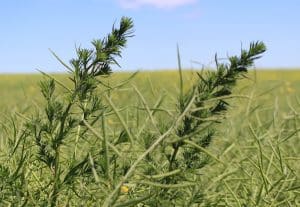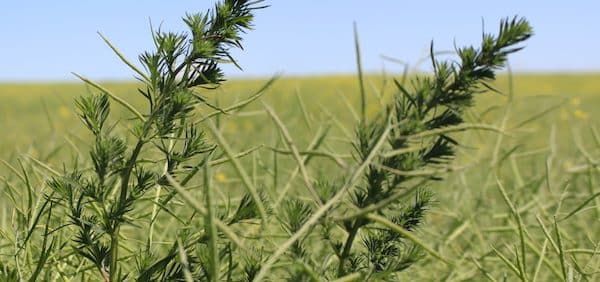Surviving weeds are growing strong and some of them — like kochia and wild oats — start to look really obvious by this time of year.

Are those patches herbicide resistant and to what? Or are they just escapes? Here are clues to distinguish between the two options:
Herbicide resistant weeds tend to:
—Be in patches of all the same weed. Other weeds were controlled while this particular species-specific patch was not.
—Be in patches of irregular shape, starting off as one weed and going out from there as seeds shell out or the combine spreads them around. In the case of glyphosate-resistant kochia, plants are often in long lines as the resistant parent tumbled along dropping seeds. Wild oats will be in patches that spread out from the original resistant plants.
Escapes tend to:
—Be multiple weed species. Weeds under the canopy may have missed herbicide contact, and these will usually be more than one species.
—Be in patches of geometric shape, perhaps in arcs in headlands where the sprayer missed on a turn.
Take a whole rotation approach to weed management. Remember that 90% or more of kochia is already Group-2 resistant, so it can be worse in pulse crops that rely on Group-2 products for weed control. With pulses in the rotation, a couple years in a different crop with various other herbicide options can get Group-2 resistant patches under control. Tank-mixing glyphosate for fall and pre-seed applications will be important to stop Group-9 resistant kochia from developing and spreading. Identifying resistant patches now when they’re obvious is essential to containing them.
Lab tests for herbicide resistant weeds. Some labs require mature seed to run their tests (wild oats, for example). Manitoba’s Pest Surveillance Initiative lab will run a DNA test on young kochia leaf material (new growth) for glyphosate resistance. Samples must be fresh and on ice when they arrive at the lab. Find PSI Lab’s kochia sampling protocols here.
Keep an eye out for any unusual weeds. This especially includes weeds you’ve never seen before. In 2015, jimsonweed was found in some Alberta canola fields. This weed tends to favour hot, dry conditions and open canopies, which we had through the first part of 2015 but not in 2016. If you find jimsonweed or any other unusual weed, contact a provincial weed specialist or CCC agronomy specialist to help with identification and discuss containment and management strategies.
Look for pre-harvest application opportunities. Pre-harvest applications can stop these weeds from setting seeds. Controlling them pre-harvest limits the seed spreading that occurs with the combine.
